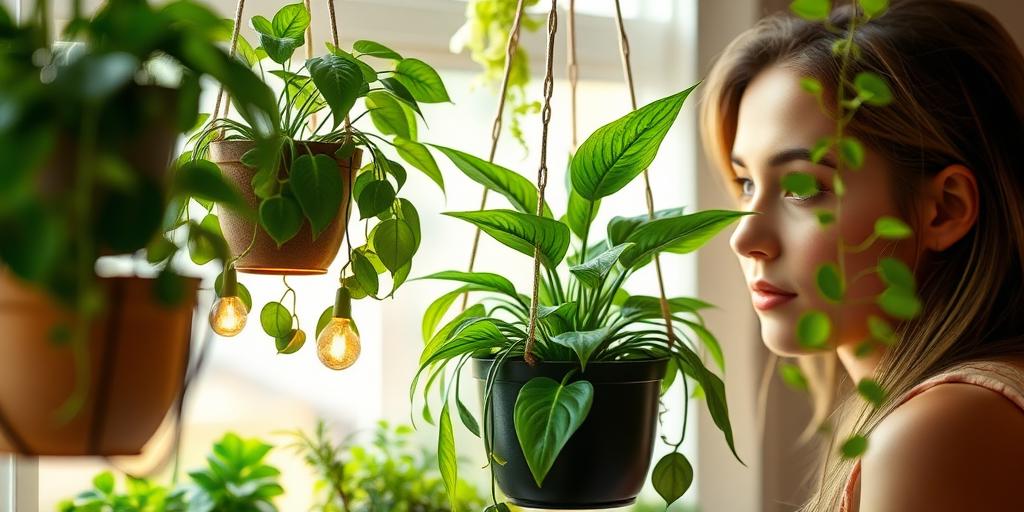
Feeding Your Low-Light Hanging Plants: Best Fertilizers for Healthy Growth
Discover the best fertilizers for low-light hanging plants to keep them thriving! Learn nutrient tips, application methods, and organic alternatives for lush, healthy growth.
Introduction
Did you know that even low-light hanging plants need proper nutrition to stay vibrant? While they may survive in dim corners, feeding them the right fertilizer can make all the difference! Whether you’re caring for a pothos, spider plant, or philodendron, choosing the best fertilizer ensures they stay lush and green—even in less-than-ideal lighting. In this guide, we’ll explore the top fertilizers, when and how to feed them, and expert tips to avoid common mistakes. Let’s get your hanging beauties the nutrients they deserve!
Understanding Low-Light Hanging Plant Needs
Even though low-light hanging plants don’t require as much sunlight as their sun-loving counterparts, they still need proper nutrition to thrive. Many people assume that because these plants grow slower in dim conditions, they don’t need fertilization—but that’s a misconception.
Why Low-Light Plants Still Need Fertilization
While low-light plants may not grow as rapidly, they still rely on nutrients to maintain healthy foliage, strong roots, and resistance to pests and diseases. Without proper fertilization, they can become weak and more susceptible to problems.
Key Nutrients for Healthy Growth
The three primary nutrients all plants need are:
-
Nitrogen (N): Essential for leaf growth and vibrant green color.
-
Phosphorus (P): Supports root development and flowering.
-
Potassium (K): Strengthens overall plant health and disease resistance.
A balanced fertilizer (such as a 10-10-10 or 20-20-20 formula) usually works well, but some low-light plants may need slight adjustments.
Signs Your Plant Is Nutrient-Deficient
If your hanging plant is struggling, watch for these red flags:
-
Yellowing leaves (often a nitrogen deficiency)
-
Slow or stunted growth (could indicate a lack of phosphorus)
-
Weak stems or brown leaf edges (potassium deficiency)
Catching these signs early allows you to adjust your fertilization routine before the plant suffers long-term damage.
Best Fertilizers for Low-Light Hanging Plants
Not all fertilizers are created equal—some work better for low-light conditions than others. Here are the top options:
Liquid Fertilizers: Easy Absorption and Quick Results
Liquid fertilizers are great for quick nutrient delivery. They dissolve in water and are absorbed rapidly by the roots, making them ideal for giving your plants an immediate boost.
-
Pros: Fast-acting, easy to control dosage.
-
Cons: Requires more frequent application.
Slow-Release Granules: Low-Maintenance Feeding
These pellets break down gradually, releasing nutrients over weeks or months. They’re perfect for forgetful plant parents or those who prefer a hands-off approach.
-
Pros: Long-lasting, reduces risk of over-fertilization.
-
Cons: Less control over nutrient release.
Organic Options: Worm Castings, Fish Emulsion, and Compost Tea
If you prefer natural solutions, organic fertilizers are a fantastic choice:
-
Worm castings: Rich in nutrients and beneficial microbes.
-
Fish emulsion: High in nitrogen but has a strong odor.
-
Compost tea: A gentle, all-purpose nutrient boost.
Synthetic vs. Natural Fertilizers: Pros and Cons
-
Synthetic fertilizers: Fast and precise but can lead to salt buildup in soil.
-
Natural fertilizers: Improve soil health over time but may act more slowly.
Choose based on your plant’s needs and your personal gardening style.
How and When to Fertilize Low-Light Plants
Timing and technique matter just as much as the fertilizer itself.
Best Time of Year to Fertilize
-
Growing season (spring & summer): Fertilize regularly (every 4-6 weeks).
-
Dormancy (fall & winter): Reduce or stop fertilizing—plants aren’t actively growing.
Frequency: How Often to Feed Your Plants
Most low-light hanging plants do well with monthly feedings during active growth. Over-fertilizing can harm them, so less is often more.
Dilution Tips to Prevent Fertilizer Burn
Always follow package instructions, but consider diluting liquid fertilizers to half-strength for low-light plants. Their slower growth means they need fewer nutrients.
Application Methods
-
Foliar spray: Mist leaves with diluted fertilizer for quick absorption.
-
Soil drench: Water the soil directly to nourish the roots.
Both methods work, but soil drenching is generally safer to avoid leaf burn.
Common Mistakes to Avoid
Even experienced plant owners make fertilization errors. Here’s what to watch out for:
Over-Fertilizing and Its Harmful Effects
Too much fertilizer can cause:
-
Salt buildup in the soil, damaging roots.
-
Leaf burn (brown, crispy edges).
-
Stunted growth from nutrient overload.
If you suspect over-fertilization, flush the soil with water to remove excess salts.
Using the Wrong Fertilizer Type
High-nitrogen fertilizers meant for leafy greens can be too strong for low-light plants. Stick to balanced or mild formulas.
Ignoring Soil pH
Nutrient absorption depends on soil pH. Most low-light plants prefer slightly acidic to neutral soil (pH 6.0–7.0). Test your soil occasionally and adjust if needed.
Top Low-Light Hanging Plants and Their Fertilizer Preferences
Different plants have different needs. Here’s what works best for popular varieties:
Pothos: Balanced Liquid Fertilizer
Pothos thrives with a balanced liquid fertilizer (10-10-10) applied monthly in the growing season.
Spider Plant: Mild, Organic Options
Spider plants prefer organic fertilizers like compost tea or fish emulsion, which are gentle on their sensitive roots.
Philodendron: Slow-Release Pellets
These plants do well with slow-release granules mixed into the soil every few months.
ZZ Plant: Light, Infrequent Feeding
ZZ plants are ultra-low-maintenance and only need light feeding (once or twice a year) with a diluted liquid fertilizer.
DIY Natural Fertilizers for Low-Light Plants
If you love homemade solutions, try these easy recipes:
Banana Peel Tea for Potassium Boost
-
Soak banana peels in water for 48 hours.
-
Strain and use the water to feed your plants.
Great for flowering plants or those needing a potassium boost.
Eggshell Water for Calcium
-
Crush eggshells and steep in boiling water overnight.
-
Strain and use the cooled water to strengthen plant cell walls.
Epsom Salt Solution for Magnesium
-
Dissolve 1 tablespoon of Epsom salt in a gallon of water.
-
Use monthly to prevent yellowing leaves.
These natural options are cost-effective and reduce waste while keeping your plants healthy!
Conclusion
Feeding your low-light hanging plants doesn’t have to be complicated—just choose the right fertilizer, follow a consistent schedule, and avoid overdoing it! Whether you prefer organic solutions or commercial blends, the key is providing balanced nutrition without overwhelming your plants. Ready to give your green friends a boost? Pick the best fertilizer from our list and watch them thrive, even in the shadiest spots!
